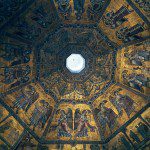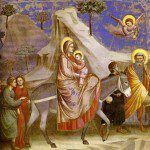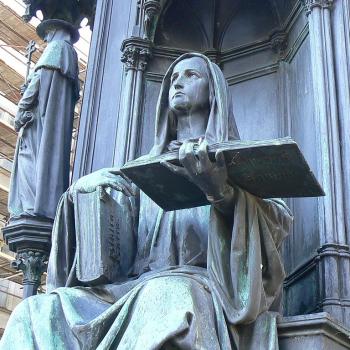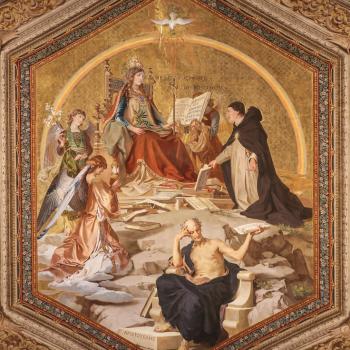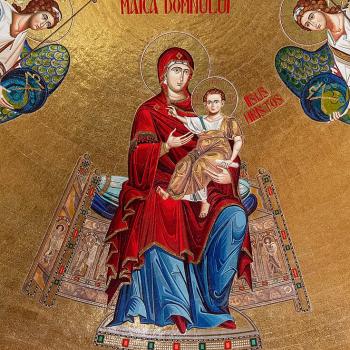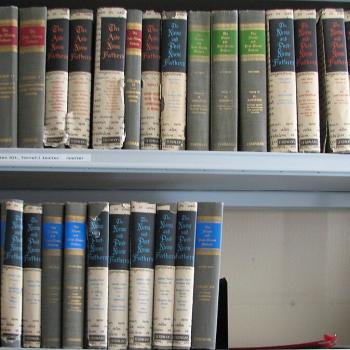![By Giotto (original fresco), SimonP (image from PD), Trelawnie (excerpt) (Public domain) [Public domain], via Wikimedia Commons](https://wp-media.patheos.com/blogs/sites/637/2016/04/Giotto_Flight_into_Egypt_excerpt-300x295.jpg)
Before we engage the question of her perpetual virginity some might ask why such a teaching is important. That is, if it could be shown historically that she really did remain a virgin all her life, and that is a big if,[1] is this not really a side-note about her, something interesting about her to be sure, but not important enough to be raised to the level of a dogma which must be believed?[2] Theologically, we can provide several reasons why this teaching is important and not just an interesting tidbit from history, but for our purpose here, we will only address some of them. The fact that it could be shown to be a historical reality should be the first such reason, that is, we should care about the historical record and what it provides because the incarnation itself demonstrates history matters. The world, and what is in it, matters. Flesh and blood matters. The truth of the Gospel must contain and integrate history, not sidestep it, less we end up following the errors of the so-called Gnostics, who think the world and what is in it is unimportant.[3]
Another reason, and one which has played a significant part in theological discussion about Mary, and will serve as our central answer here, lies with the prophecies about Jesus which can be shown to also be concerned about Mary. For example, in Isaiah 7:14, we are told a virgin shall conceive Emmanuel.[4] This prophecy indicated something about Mary (her virginity), even as it says something about Jesus (he is God-with-us, that is, the God-man). If she did not remain a virgin all her life, could she truly be designated as a virgin? Prophecy tends to present people in relation to who they really are: Jesus is the God-man, his mother is the virgin. Moreover, if she lost her virginity later, would not Jesus’ opponents be able to use that to question whether or not she was a virgin when she gave birth to Jesus? By remaining a virgin throughout her life (and being able to prove it, if necessary), she preserved, within herself, a witness to the fulfillment of Isaiah’s prophecy.[5]
While prudence would suggest to Mary that she should remain a virgin for the sake of preserving the miraculous sign of Isaiah to the world, we have yet another prophetic record which is read by Christians as indicative of her perpetual virginity. This prophecy is found in the book of Ezekiel. In it, we read that the Lord shall come through a gate which no one else can come through, that it will be shut to everyone but him:
Then he brought me back to the outer gate of the sanctuary, which faces east; and it was shut. And he said to me, “This gate shall remain shut; it shall not be opened, and no one shall enter by it; for the LORD, the God of Israel, has entered by it; therefore it shall remain shut. Only the prince may sit in it to eat bread before the LORD; he shall enter by way of the vestibule of the gate, and shall go out by the same way” (Ez. 44: 1-3).
There is no gate, in the normal sense, in which this could apply. Point to any conventional gate, and while it might be closed, there is always a way to have it opened. This is especially true in regards the temple, because we know what happened to it: it was destroyed, and people passed through all of its gates while destroying it. Now, to be sure, Ezekiel saw the temple as giving a representation for a theological truth, and so it is true that the temple was involved in the prophecy and an element of it was implied in this verse, but only because the temple and its gates served to foreshadow a truth about incarnation as we find a new, greater temple being established by Jesus, the temple of his body.[6] The entrance to that temple was the entrance the Lord used to enter into the world to become incarnate, that is, the womb of his mother, Mary.
St. Ephrem the Syrian beautifully portrays this truth in a hymn:
A wonder is Your mother: The Lord entered her
and became a servant; He entered able to speak
and He became silent in her; He entered her thundering
and His voice grew silent; He entered her Shepherd of all;
a lamb he became in her; He emerged bleating.
The womb of Your mother overthrew the orders:
The Establisher of all entered a Rich One;
He emerged poor. He entered her a Lofty One;
He emerged humble. He entered her a Radiant One,
and He put on a despised hue and emerged.[7]
God came through the gate, and now it is shut. To say she had other children, to say Joseph would dare violate the gate of the Lord, is paramount to say she is not the gate, and Jesus is not the messiah. For what other gate could he have gone through which none other follow?
More to Come
[1] It is very difficult to establish a historical biography in a way everyone who reads it will accept what is presented in it. What sources are we to use? If all we have is Scripture, this puts a great limit to our knowledge of her, because it contains only a few events of her life in it. Of course, early Christians knew more than what was contained in Scripture, and we find, every early on, they were writing down what they heard and believed to share with each other. How are we to use these texts? While others can and will have good reason to question my choices, for simplicity sake, I will follow the general disposition established by early Christians combined with the general outline of her life preserved in the Eastern Christian tradition and its calendar. As this is not a work of history, but a work dealing with history, I admit I am taking a short cut here by not asking and answering all historical questions concerning the traditions I will be using and accepting for my presentation. The reason I am doing this is simple: my main interest is theological, but knowing that there is a received history for Mary, it is important to employ it, to show how the Marian teachings have a concrete representation in the Christian tradition showing that, like Jesus, we are not dealing with a docetical Mary, but the Mary who we believe truly had a historical life which was preserved in the memory of the ancient Christians and through their memory has come down to us today in a form which we can use for our discussion.
[2] Obviously, the early witness to her perpetual virginity is important in demonstrating the antiquity of this belief, to show it was not a theological creation which later tried to create a history to fit what Christians thought Mary should have been like. Theology learned from her actual life, her actual virginity, to understand the dogmas which are reflected in it, especially when that virginity was questioned. Jerome in his work on her perpetual virginity asked why those who know the tradition would deny it and say other things about Mary, justifying it by the silence of her life they found in Scripture, as if it could be the only source Christians had for history. His point is a solid one: arguments based upon silence are not persuasive, and when tradition is not silent, any argument against tradition must come from a clear positive argument based upon Scripture and dogmatic theology and not on silence alone.
Our sources here will include, but will not be limited to, what is found in works such as the Protoevangelion of James, writings from various patristic authors which discuss her life and death, and finally, St. Maximus’ Life of the Virgin. While the Protoevangelium is not authoritative, it is a good representation of early Christian understanding of Mary, and what Christians told each other about her and her life. The text seems to come out of that the earliest oral teachings on Mary, making it a very important document, even if it needs to be sifted through and not followed as if it were an infallible text. While various details in the text are questionable, which is why it is not entirely reliable, it would be unwise to dismiss the text as a whole, because of how readily its outline is confirmed by other, early writers, some who believed the text authentic, and others who did not. We will also turn to writers like Origen, St. Augustine, St. Jerome, St. Cyril of Alexandria, St. Andrew of Crete, and John of Thessalonica, each who also serve as a witness of the early Christian understanding and knowledge of Mary’s life, and give us further details about her life and death, making their thoughts worthwhile for our consideration. Finally St. Maximus the Confessor seems to have done considerable work to bring together the first major biography on Mary’s life, making it a worthwhile end point for the sources which we use to understand the early Christian tradition on the life of Mary. This is not to say no more was said of her after St. Maximus, but what comes after is a continuation and elaboration of the tradition which had become established by his time rather than offering us new historical sources for the ancient beliefs about Mary for our consideration.
[3] Scripture at many indications, such as Romans 8:22, indicates the effect of Christ is imparted upon the world and not just believers, and so any theology which does not take this into consideration end up losing sight of the work accomplished by him.
[4] Many try to debate what the text means and imply that the prophecy only says a young woman shall conceive, not that she would be a virgin. And yet the kind of young woman implied by the text is a virgin, which is why the early Greek translators of the text understood it to mean a virgin and translated the text to suggest that interpretation. It was not about some young woman giving birth, because that would not be unusual and signify anything. There had to be a reason why the young woman’s pregnancy could be a sign. It is because she is a virgin, a young woman who was unwed, and who had no sex, that makes her pregnancy a sign, for in this manner, it indicates God’s presence in the world doing something special in and through her.
Early Christians often found Jewish and pagan critics of Christianity questioning their reading of Isaiah, saying, as indicated above, that all Isaiah said is that a young woman shall give birth to Emmanuel. But, as those who responded to this argument said, this interpretation was made later, and was not the traditional understanding of the text. Early Christian apologists like Origen suggested it was read into the text solely to reject Christian teaching:
Now, if a Jew should split words, and say that the words are not, “Lo, a virgin,” but, “Lo, a young woman,” we reply that the word “Olmah”— which the Septuagint have rendered by “a virgin,” and others by “a young woman”— occurs, as they say, in Deuteronomy, as applied to a “virgin,” in the following connection: “If a damsel that is a virgin be betrothed unto an husband, and a man find her in the city, and lie with her; then you shall bring them both out unto the gate of that city, and you shall stone them with stones that they die; the damsel, because she cried not, being in the city; and the man, because he humbled his neighbour’s wife.” And again: “But if a man find a betrothed damsel in a field, and the man force her, and lie with her: then the man only that lay with her shall die: but unto the damsel you shall do nothing; there is in her no sin worthy of death.” — Origen, Against Celsus in ANF(4):411.
Origen continued, after pointing out how the word used is used for virgin in other texts of the Scripture, to point out the absurdity of saying it meant “young woman”:
What kind of sign, then, would that have been— a young woman who was not a virgin giving birth to a child? And which of the two is the more appropriate as the mother of Immanuel (i.e., “God with us”)—whether a woman who has had intercourse with a man, and who has conceived after the manner of women, or one who is still a pure and holy virgin? Surely it is appropriate only to the latter to produce a being at whose birth it is said, “God with us.” And should he be so captious as to say that it is to Ahaz that the command is addressed, “Ask for yourself a sign from the Lord your God,” we shall ask in return, who in the times of Ahaz bore a son at whose birth the expression is made use of, “Immanuel,” i.e., “God with us?” And if no one can be found, then manifestly what was said to Ahaz was said to the house of David, because it is written that the Saviour was born of the house of David according to the flesh; and this sign is said to be “in the depth or in the height,” since “He that descended is the same also that ascended up far above all heavens, that He might fill all things.” –ibid., 411.
[5] And this, many have pointed out, Joseph was able to do: so long as he was alive he was able to serve as witness to her virginity, for who would know better than he? But if she abandoned virginity after giving birth to Christ, that would, again, leave open the question to those who met Christ later whether or not Christ and Mary fulfilled the prophecy of Isaiah.
[6] Jesus talks about his body as being the true temple in the Gospel of John, where he predicts his resurrection from the dead: “Jesus answered them, ‘Destroy this temple, and in three days I will raise it up.’ The Jews then said, ‘It has taken forty-six years to build this temple, and will you raise it up in three days?’ But he spoke of the temple of his body. (Jn. 2:19-21 RSV). Here, we see how the relationship between Jesus’ body and the temple created confusion, for the temple itself was but a representation of the incarnate God. Discussions of the temple must somehow relate to the body of Christ. When this is not understood, then Jesus’ words about the temple are not able to be understood.
[7] St. Ephrem the Syrian, Hymn 11 in Ephrem the Syrian: Hymns. trans. Kathleen E. McVey (Mahwah, NJ: Paulist Press, 1989), 132.
Stay in touch! Like A Little Bit of Nothing on Facebook:
A Little Bit of Nothing


